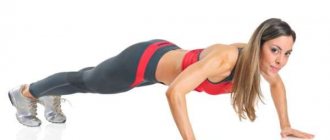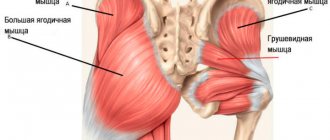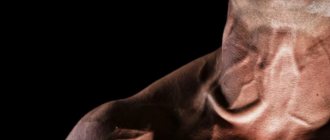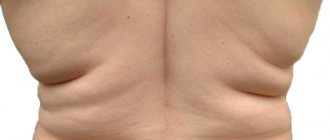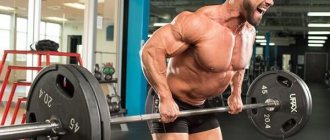- July 30, 2018
- Workouts in the gym
- Max Kozlov
Barbell shrugs are one of the few isolation exercises for the trapezius muscles. Difficulty level: easy.
The exercise consists of maximum shoulder raises (shrugs), with a barbell (or dumbbells) in your lowered, straight arms.
The upper part of the trapezius is mainly loaded. In addition to them, the rhomboid muscles and the muscles that lift the scapula are involved.
Standing shrugs with a barbell
This exercise is an isolating exercise, in which the trapezius is targeted.
- Place the barbell on the power rack supports so that it is slightly above your knees. This will remove the strain on your back when lifting the unit. If you have problems with your back or lower back, try incline shrugs.
- Holding the bar with your hands, slightly wider than your shoulders, turn your palms towards the body.
- The back should be straight and tense. Place your feet shoulder-width apart and look up.
- The shoulder blades are retracted.
- Remove the unit by lowering your shoulders down, doing a trapezius stretch.
- As you exhale, begin lifting the barbell up until it stops.
- Stay at the highest point for a couple of seconds.
- When you inhale, return to the starting position.
What are the benefits of doing the exercise while standing?
Performing shrugs with a barbell while standing makes it possible to pump up the trapezius muscles, as well as achieve the following effects:
- strengthen leg muscles;
- ensure indirect development of the shoulder girdle;
- create a stronger muscular corset of the thoracic spine;
- distribute the load evenly between all muscles of the musculoskeletal system;
- minimize the risk of injury;
- increase the body's endurance.
Performing this exercise in a standing position makes it possible to improve the overall functionality of the body and acquire technical skills for creating intense physical activity on isolated trapezius muscles.
Shrugs with a barbell behind your back
To fully pump the upper trapezius and rear deltoids, use a lighter weight when working.
- The barbell is installed in a power frame above the knees.
- Turn your back to the frame, palms facing your torso.
- The back is straight, the gaze is directed upward. The legs are spaced slightly less than shoulder width apart.
- Grab the barbell and perform a quick lift. At the peak, hold for a couple of seconds.
- The descent should be slow. Control the work of the trapezius by maintaining the deflection of the elbow joint. Hands should not be used during movement.
Application
Intended for: Everyone, from beginner to professional.
When: At the beginning of trapeze training. Midway through your workout, perform dumbbell and/or barbell shrugs and chin-up rows.
How much: 3-4 sets of 10-15 repetitions.
Sports instruction: In bodybuilding, shrugs with a barbell are performed in order to increase the volume of the upper neck and back, and to draw the dividing line between the deltoids and trapezius.
Regularly performing shrugs with a barbell will improve your skills in volleyball (throws and balls and blocking with outstretched arms, strikes), gymnastics (exercises on uneven bars and horizontal bars) and other sports that typically involve lifting the shoulder blades and performing various arm movements from an overhead position. head: , javelin throwing, baseball, tennis (ball serve).
On a horizontal bench
The work takes place on the anterior and middle deltas and upper trapezius. The chest muscles are also involved to a small extent.
- Place the barbell on the racks and lie horizontally with your back on the bench.
- The feet should be on the floor.
- To perform a press, the pins should be installed about 10 centimeters from the starting position.
- Grasp the unit with a vertical shoulder grip.
- When removing weights from the racks, your arms need to be tense at the elbow joints. This will become the starting position.
- Keeping your arms tense, squeeze your shoulder blades together and press your shoulders into the bench. At this moment the unit will lower slightly.
- As you exhale, spread your shoulder blades and lift your shoulders slightly off the bench.
- Make sure that your arms do not bend at the elbows, and that your head and upper back do not rise from the bench.
- When raising your shoulders, you need to tense your chest muscles and bring them together.
- Important. When reaching the peak, the unit should be approximately 8 centimeters higher than with a classic bench press.
- If difficulties arise in keeping the unit in the correct position, then the pins will hold it in place.
To lift the barbell vertically correctly, your arms must work simultaneously when working.
Tips and tricks
By adhering to some nuances, you can train the trapezius more quickly and effectively:
- To work with maximum amplitude, first of all, before starting the technique, you should stretch your shoulders, you can also hang on the bar for some time and perform partial pull-ups. The athlete needs to be completely relaxed between repetitions.
- With a high shoulder lift, there is a strong contraction of the upper parts of the trapezius muscle, as well as the muscle that raises the scapula. This helps increase muscle mass.
- When performing trapezoid training, you do not need to completely relax your muscles between repetitions. Otherwise, the load will move forward.
- To perform the exercise correctly, the athlete's gaze must be directed forward, which will allow him to keep his torso in the correct position.
- Breath-holding repetitions help keep your torso straight. This in turn will allow the muscles to work more efficiently and reduce the load on the spine.
How often to exercise
To pump up the trapezius, one workout per week is enough. But it is worth remembering that this muscle will grow only with complex exercises with the muscles of the back and shoulders.
Jumping shrugs with a barbell
This exercise pumps not only the trapezius, but also the smallest muscles in the upper back.
Yes, this is possible
- The bar is taken at a distance slightly wider than shoulder width.
- Your back is straight, your feet are shoulder-width apart.
- With your knees bent, you want the bar to be at about mid-thigh level.
- With a disruptive force, straighten up and push your body into a vertical momentum of movement, performing a synchronized pulling movement with your shoulders.
- Then smoothly return to the starting position.
Explosive shrugs are performed with maximum working weight. For such an exercise you need to have a high level of preparation.
Advice. The movement of the shoulders is important for explosive shrugs, since you cannot pause at the top point; you must immediately lower the weight to the starting point.
Common mistakes
Beginning athletes who perform standing barbell shrugs for the first time quite often make the following mistakes:
- using sports equipment that is too heavy;
- do not perform a high-quality warm-up of the cervical, thoracic and lumbar spine, which ultimately leads to injuries;
- exercising too intensely, which creates unwanted stress on the heart and blood vessels;
- do not undergo a preliminary examination by a cardiologist;
- during exercises, they move their shoulders forward, slouch and round their back, which subsequently negatively affects their posture;
- do not monitor the breathing rhythm, disruption of which can cause the development of cardiovascular diseases;
- carry out rotational movements of the shoulders, which lead to injury to the joints (in this case, only the trapezius muscles should be involved).
In order to avoid mistakes in performing shrugs with a barbell while standing, you need to start training under the guidance of an experienced trainer or fitness instructor. A specialist will help you take the starting position correctly and control your technique of working with sports equipment.
Features of performing shrugs with a barbell
- You should pick up the projectile, holding it below with straight arms.
- When raising your shoulders, do not bend your elbow joints.
- Having reached the peak, you need to linger for a few seconds and return to the starting position.
- Use a curved bar when working with a barbell
- During operation, the weight is held firmly, in constant tension.
- During the approach, make sure your back is straight, keep your back and abdominal muscles tense.
- Choose the right weight to do the perfect 10 reps for 3 sets.
- When performing exercises, you need to feel the trapezius working.
Advice. Regardless of the choice of exercise, the main thing is to eliminate rotation in the shoulder joints. Also, do not relax your shoulders at the bottom point; allow all the weight to be transferred to your outstretched arms.
Safety precautions
Standing barbell shrugs are an exercise that can cause injury to the cervical or thoracic spine.
In order for this type of physical activity to bring only benefits, you must follow the safety rules:
- Select the optimal working weight of the barbell, which corresponds to the individual physical capabilities of the athlete.
- When performing shrugs, always ensure that your back remains as straight as possible, as rounding it will lead to poor posture.
Standing barbell shrugs must be performed correctly. It is important to keep your back straight. - Use a safety belt that is fixed at the waist line, protecting the lumbar spine and the anterior abdominal wall while lifting the barbell.
- The time interval between performing the next approach should be 3-5 minutes so that the body has the opportunity to fully recover, but at the same time creates a maximum load on the trapezius muscles.
- Eliminate the factor of rotation of the shoulder joints. The weight of the barbell should be selected so that during training the physical load falls only on the trapezius muscles.
- During the training process, you should monitor your general well-being, the number of pulse beats and breathing rate.
- Before each lesson, conduct a full warm-up with warming up the muscles of the cervical, thoracic and lumbar spine, the average duration of which should be at least 15 minutes.
Performing shrugs with a barbell while standing should be avoided by people who initially have problems with blood pressure, suffer from disturbances in the outflow of venous blood, as well as severe deformation of the chest caused by curvature of the spine.
Before you start training to develop the trapezius, you will need to undergo a comprehensive examination by a cardiologist, neurologist, or surgeon.
What exercises are best to do shrugs on the same day?
Two options will be acceptable:
- The trapezius muscle must be worked with deltoids. Here is a small list of exercises compatible with shrugs: standing dumbbell press, dumbbell up and down, bent over butterfly.
- Joint back workout.
Performing shrugs on delta training days is the right decision. Since arm raises and presses put stress on the upper trapezius, shrugs will be just a direct hit.
On back training days, the middle part of the trapezius takes on additional load, therefore, shrugs will not be very effective.
However, to achieve a combination of a massive front trapezius with a back, you need to combine training days with deltoids and back twice a week.
Benefits of exercise
Shrugs with a barbell, performed while standing, involve the use of classical or therapeutic techniques.
The organization of the training process involves achieving different results of physical activity.
Classical technique
The classic technique of performing shrugs in a standing position is designed to develop the trapezius as quickly as possible. The main emphasis of the training is on increasing the volume of muscle mass, or achieving a relief effect.
The benefits of the classic barbell shrug technique are as follows:
- rapid growth of the trapezius muscle;
- increasing trapezius muscle strength;
- creating the effect of relief of the trapezius muscle with its highlighting against the general background of the shoulder girdle;
- thickening of the neck and simultaneous shortening of its length.
The main benefit of the classic technique of performing shrugs with a barbell is that through properly organized training, the athlete acquires a powerful trapezius muscle, which allows him to create a large load on other elements of the musculoskeletal system.
For example, it increases physical strength and the potential to lift maximum weights in weightlifters. Wrestlers who have a pumped trapezoid and a short and wide neck protect themselves from painful holds in the form of choking from behind or from the front.
Therapeutic technique
Shrugs with a standing barbell are performed not only to build muscle mass, but are also aimed at preventing diseases of the musculoskeletal system.
The therapeutic technique of these exercises is part of physical therapy, which provides the following benefits:
- protects the cervical and thoracic spine from injury and physical stress;
- strengthens the muscles located around the spinal column;
- promotes the outflow of venous blood from the occipital region of the head;
- provides more active cerebral circulation;
- allows you to get rid of the negative consequences of chronic osteochondrosis of the cervical spine;
- improves posture (this benefit of the therapeutic technique of shrugs with a barbell is especially pronounced in relation to men and women who have been diagnosed with the initial stage of kyphosis);
- accelerates the healing process from scapular and shoulder periarthritis.
People who perform therapeutic shrugs with a barbell should use minimal weights to avoid causing injury to the cervical spine. Especially if a person already has chronic diseases of the musculoskeletal system.
During training, it is strictly forbidden to pull your chin forward or lift it up, as this can lead to stretching of the neck muscles. Barbell shrugs, aimed at the prevention and treatment of chronic diseases, are performed with the chin down, which is pressed to the upper chest.
Anatomical characteristics of the trapezoid!
The human back muscles are divided into two categories: deep and superficial. The first category includes all muscle tissues responsible for the internal functioning of the back. Muscle groups of the second category perform the most difficult work associated with human physical activity.
It is the superficial muscles that we develop through various training programs and exercises. This group includes: the latissimus, extensors and trapezius muscles of the back.
Physiologically, the trapezius is located on the upper back and ends directly on the neck. Unlike other muscle groups, the trapezius is divided into three separate areas: bottom, top and middle.
Features of training
For each person, training the trapezius muscle can be different, based on their physiological capabilities. But there is a more generalized training method:
1) Active voltage
This is a method in which the muscle is worked “to failure”. In this case, no more than 3 exercises are performed.
2) Intervals
Take breaks between sets until you feel that the trapezius has recovered and is ready to continue. Try to do 4-5 approaches.
3) Increase in mass
The so-called pyramid. Starting with a small weight, with each approach you add more, and so on until failure.
4) Work with maximum weight
Repetitions should be up to 15 times. If your strength allows you to do more, then this is not the maximum weight.

